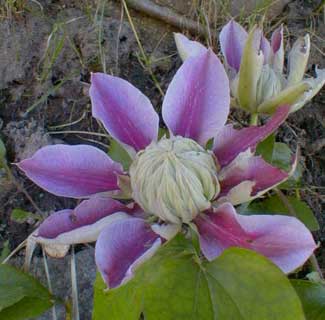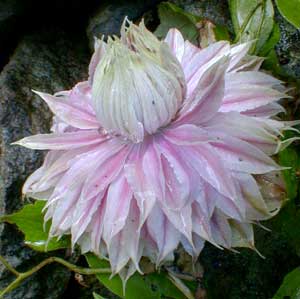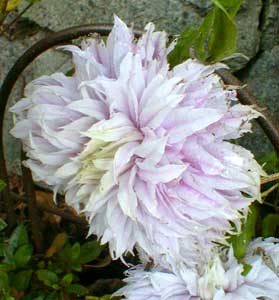
'Josephine' or 'Evijohill'
Double-flowered Clematis
'Tis various -- as the various taste --
Clematis -- journeying far --
Presents me with a single Curl
Of her Electric Hair --
-Emily Dickinson,
1830‚1886
1830‚1886
This mysterious hybrid clematis is trademarked & sold under the name 'Josephine,' but also has the registered cultivar name 'Evojohill,' after Josephine Hill & Raymond Evison.
It was an accidental discovery made by Josephine Hill in the 1980s, when she purchased an unflowering clematis vine in a Twickenham market in London.
For years she could not get the variety identified, until it was seen by clematis expert Raymond J. Evison, who realized it was unidentifiable because it was one of a kind.
Raymond Evison developed it for sale through his wholesale nursery Guernsey Clematis, & it reached the marketplace in 1998. That same year it received the Chelsea Flower Shop Award.
 Evison is a recipient of the Royal Horticultural Society Victoria Medal of Honor (1995), the Order of the British Empire (2000), & many other honors. He is the author of The Gardener's Guide to Growing Clematis (1998) & Clematis for Everyone (2000). In 2004, a selection of his clematis creations were selected for a set of Guernsey Island postage stamps!
Evison is a recipient of the Royal Horticultural Society Victoria Medal of Honor (1995), the Order of the British Empire (2000), & many other honors. He is the author of The Gardener's Guide to Growing Clematis (1998) & Clematis for Everyone (2000). In 2004, a selection of his clematis creations were selected for a set of Guernsey Island postage stamps!'Josephine's' trellised vine can grow eight to twelve feet high & wide, possibly fifteen feet in time. The huge flowers have an elaborate structure. The large outer tepals usually number eight. These will be green if it blooms in shade, but mauve to lilac-pink when it blooms in sun.
Depending on position, for later flowers the tepals will be increasingly or decreasingly green, but with a green stripe through the center of each large tepal. These outer petals will also spend a few days rolled like a star of cigarette papers, until a sunny day unfolds them entirely.
Meanwhile the inner part of the flower is made up of layer upon layer of slender thin pointed tepals that look like a fully double rosette, like a small clematis inside a large clematis, usually a darker pink the largest outer petals, though this varies depending on sun exposure & time of year.
Inside the pink rosette are still smaller & more numerous pale cream-colored to greenish-pink tepals or staminoids which look like a pompom. So in all, a pompom seemingly pasted in the center of a small pink rosette tacked inside a giant pink, white, & green flower.
 In April this central ball of petals is quite tightly compact, but in May it fluffs out more & more & more, the outer part of the pompom fluffling out first, followed serially by layer after layer of the exceedingly numerous staminoids.
In April this central ball of petals is quite tightly compact, but in May it fluffs out more & more & more, the outer part of the pompom fluffling out first, followed serially by layer after layer of the exceedingly numerous staminoids.These flowers continue to evolve & develop through the whole of May & much of June. At some point in May, the outermost large petals & the inner rosette have worn out & fallen away, but the central pompom is still extremely vital & intact. By June all the staminoids have completely unfolded.
The first photo above shot in April shows a bloom during its early beauty before the large outer petals fade & while the inner pompom is still tightly closed.
The second photo was shot in May when the large petals are gone but the inner pompom is partially opened.
The third photo from the start of the second week in June shows the finished fluffy pompom, only just beginning to get scruffy & worn out.
The flowers are invariably doubles That the blooms are easily present for ten weeks or more is phenomenal, the result of its sterility, since fertile flowers would begin to go to see after being pollinated but this sterile clematis doesn't know when to stop trying to attract pollinators.
Not only are the vines aflower a long time through late spring & early summer, but it frequently reblooms in autumn. Although there are many clematis cultivars that have this later rebloom, few have flowers that individually last so long & evolve through so many different looks. It's as close to an ever-blooming clematis as is apt ever to exist.